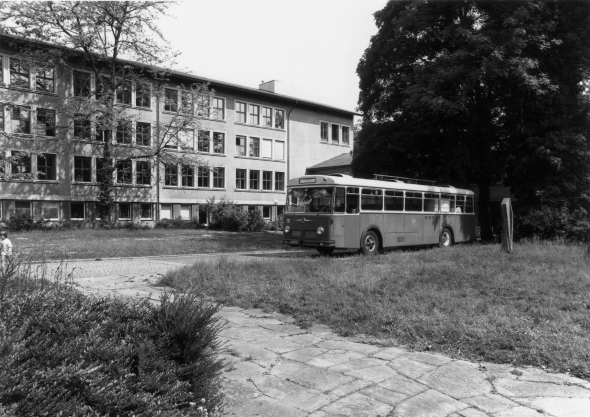
Bibliobus in front of the Champagne Primary School next to Bernhard Luginbühl, “Aggression,” 1962, at left.
Bibliobus in front of the secondary school building in Rittermatte next to Hans Aeschbacher, “Figur I,” 1955, on right.
Bibliobus in front of the vocational school next to Jean Tinguely and Bernhard Luginbühl, “Tiesenkandelaber” 1975, on right.
Detail, Bibliobus interior.
Detail, giant sticker placed on the front of the bus showing a stuffed eagle with a stuffed groundhog in its claws.
Bibliobus
26 May – 29 September 1991
“Tabula Rasa” and the public space of Biel, Switzerland
Bus, bookshelves, photocopier, two tables, plaques with text, adhesive film
Six locations, each for three weeks:
– Champagne Primary School, next to Bernhard Luginbühl, “Aggression,” 1962
– Rittermatte Secondary School, next to Hans Aeschbacher, “Figur 1,” 1955
– Vocational School, next to Jean Tinguely and Bernhard Luginbühl, “Riesenkandelaber,” 1975
– Strandboden High School, next to Ueli Berger, “Jura,” 1980
– Technical School, next to Arnold d’Altri, “Die Schatten,” 1956
– Seminar Linde, next to the Berner Arbeitsgemeinschaft, “Farbige Baumruine,” 1975
Tabula Rasa consisted of a monument in the urban space of Biel, the artist’s home town. For the ninth Swiss Sculpture Exhibition in Biel, curator Bernard Fibicher invited 26 artists, among them Christian Philipp Müller, to produce monuments for the city. The resulting installations and sculptures were distributed throughout the urban space. In contrast to the permanent status traditionally claimed by public monuments, the participants placed temporary markers in the city, elaborating or commenting on existing structures.
Müller’s work moved throughout the city of Biel. The artist took a municipal bus that had been removed from service and positioned it in the parking lots of six schools in Biel for three weeks at a time. The tour began with an elementary school and ended in front of a state teacher’s college. The red bus functioned as a sculpture that could be entered. Here in Biel — the epicenter of art in the public space in Switzerland — Müller systematically elaborated on a work initiated by Michael Asher in the Skulptur Projekte Münster exhibition of 1977. Asher’s installation for Münster, a four-meter-long white camper, was moved weekly throughout the city over the course of the exhibition, appearing in nineteen different locations. Müller’s bus, on the other hand, not only drew attention to existing situations but also interacted with them. The bus could be entered and used; its rear section housed a library, a desk, and a copier. In the library, Müller exhibited the art publications available in the school library at that particular location, making it possible for visitors to study them and make copies for personal use. In this way, he called attention to materials and books that had previously remained unnoticed, reintroducing the idea of education through art. During daily opening hours, segments of the population met here that were normally as isolated from each other as they were from the exhibited materials. In typical fashion for public transit advertising, banners and signs mounted on windows, ceilings, and walls showed quotes by writers from Jean-Jacques Rousseau to Tim Rollins emphasizing the importance of good art and architecture in pedagogy. The educational function of art was thus transferred from its traditional institutions to a work of art in public space. On the front and rear windows of the bus were giant stickers showing a motif found by Müller in the scientific collection of a school in Biel: a stuffed eagle bearing a stuffed groundhog in its claws.
Essay by George Baker available here.



